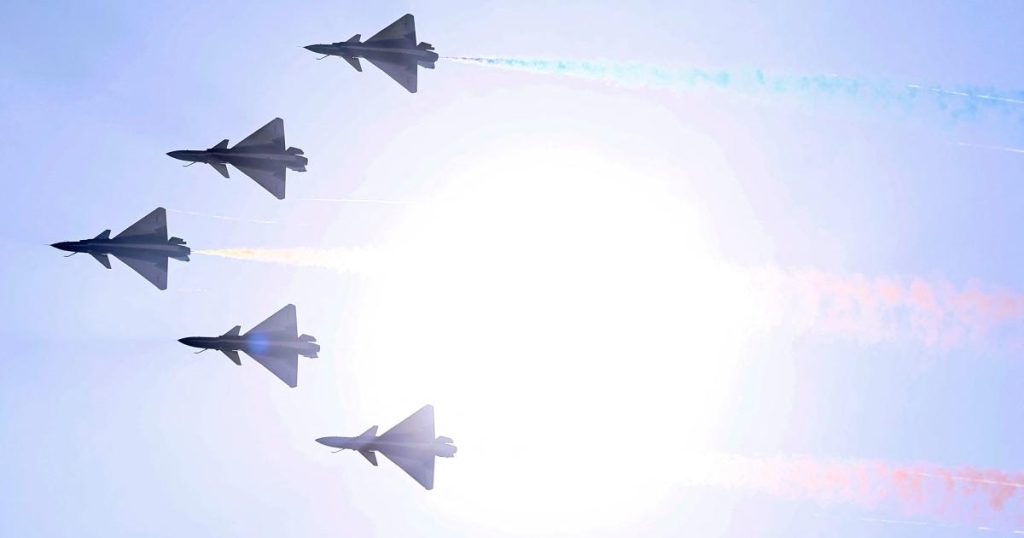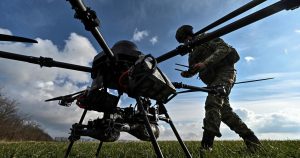China’s armed forces are changing quickly. Over the last 15 years, Beijing has devoted significant resources to developing a military that can project power abroad. It now has three aircraft carriers and a growing fleet of amphibious assault ships. In 2017, China opened its first overseas military base in Djibouti. Chinese ships have also docked at ports scattered around the Indo-Pacific, from Cambodia to Sri Lanka. These changes should not be surprising since Chinese officials have spoken publicly about how they see their country as a great power on the rise, one that must project power overseas.
The problem for Beijing is that power projection, in the form of a large blue-water navy and overseas bases, is increasingly expensive. Technological advances are remaking warfare, encouraging states to build cheaper and more expendable weapons that can limit the effectiveness of larger, costlier platforms. China is embracing power projection at exactly the wrong moment. It is effectively swimming against the technological tide. The United States must not make the same mistake. It should swim with—not against—the current, adjusting its mix of military forces to better accommodate the realities of warfare in the twenty-first century.
BAD TIMING
China’s rise has been one of the most rapid in global history. Until 15 years ago, however, its armed forces largely eschewed the traditional trappings of great powers. Rather than build a large blue-water navy and overseas bases, Beijing invested in weapons intended to stop adversaries from encroaching on Chinese territorial and maritime space. These capabilities—including long-range missiles and stationary mines—were intended to offset more advanced U.S. ships and aircraft. By the first decade of the twenty-first century, many U.S. experts feared that China’s numerous and relatively cheap missiles could threaten the United States’ more expensive ships, aircraft, and forward bases.
Today, however, the tables are turning. Beijing has shifted much of its spending toward power projection. A 2024 U.S. Defense Department report observed that China will “increase its focus on expanding power projection operations globally.” Chinese Admiral Wu Shengli, a key architect of the shift, explained in 2006 that China required “a powerful navy to protect fishing, resource development, and strategic passageways for energy.” Other motives behind this expansion include China’s preparations for invading Taiwan, its desire for prestigious weapons, and the inclinations of Chinese leader Xi Jinping.
But there is something even more fundamental at work: China is following the well-trodden path of most great powers. As they rise, peak, and decline, countries shift their national objectives, defense strategies, and military investments in predictable ways. Rising powers typically adopt power projection in pursuit of expansionist objectives. Peaking powers usually seek consolidation, often by fortifying defensive positions. And declining powers traditionally choose more limited objectives that they can accomplish with cheaper and more expendable military systems.
Beijing’s turn toward power projection is therefore the natural result of the Chinese Communist Party’s conviction that the country is now a leading power. As Xi asserted in 2019, “The Chinese nation has achieved a tremendous transformation: it has stood up, grown rich, and is becoming strong.” Xi has jettisoned the “active defense” strategy espoused by earlier generations of Chinese leaders, which called for China to remain defensive in orientation but able to launch offensive operations if necessary. Instead, Beijing has embraced new military capabilities designed to project power across the Indo-Pacific and around the world. Just like those of Germany or the United States in the 1890s, China’s leaders are determined to build a blue-water navy and operate globally. China now commands the world’s largest navy with the support of a widening array of overseas bases and access locations.
As they rise, peak, and decline, countries change their military strategies in predictable ways.
Unfortunately for China, Beijing has committed to power projection at the wrong time. Expendable systems, such as drones and missiles, are becoming increasingly effective despite their relatively low cost. Warfare is changing as governments prioritize the deployment of these cheaper weapons at scale. These systems can blunt the effectiveness of the large and expensive platforms, such as aircraft carriers, integral to power projection. Shifts in the conduct of war threaten to make power projection more difficult to achieve.
The war in Ukraine has demonstrated that it is becoming more expensive to project power. On the modern battlefield, cheap drones and improvised explosive devices menace ground forces, uncrewed vessels and antiship missiles threaten surface ships, and sophisticated air defenses imperil aircraft. In short, technological advances have made control of territory, water, and airspace more difficult and more costly. Investments in power projection are therefore less cost-effective, making missions that require power projection riskier and more expensive.
To be sure, China’s embrace of power projection has rattled U.S. policymakers. Speaking on Fox News in 2024, Frank Kendall, the secretary of the U.S. Air Force, warned that the United States was in a race it could lose. “Our cushion is gone,” he said. “We are out of time.” The U.S. military has spent over a century perfecting the tools and craft of projecting power, only to see China match many of those capabilities and field them in larger numbers. Distracted by overseas wars, Washington has modernized its forces too slowly.
But the United States has an opportunity to turn the tide. China’s People’s Liberation Army requires expensive and vulnerable power-projection platforms, such as aircraft carriers and amphibious assault ships, if it is to cross the open ocean and conquer Taiwan by force. By contrast, the U.S. military’s main objectives are to deter adversaries from attacking U.S. territory or that of U.S. allies and partners. Maintaining the status quo is much easier than changing it. The United States and its allies can therefore adopt elements of China’s earlier strategy—Beijing’s prior focus on denying encroachment on its territory—to check the Chinese military’s attempts to project power. To do so, it must heed the recommendations of experts who have called for the United States to field smaller, cheaper, and more expendable systems in larger numbers.
IN THE MIX
Great powers do not overhaul their militaries overnight—nor should they. As Admiral Samuel Paparo, head of the Indo-Pacific Command, noted in 2024, the United States cannot just “quit on everything” related to power projection simply because “we’ve got some drones.” Rather, leaders must rebalance their strategies by adjusting the mix of military capabilities. To project power, the United States has focused for years on developing strong offensive control platforms, such as aircraft carriers. Now is the time to add more systems designed for defensive control and denial, such as the Replicator initiative announced in August 2023, an ambitious Defense Department program to cheaply produce drones and other expendable weapons in large numbers.
The result should be a strategy that combines three types of capabilities: expendable uncrewed systems, such as drones and missiles; stealthy penetrating platforms, such as B-21 bombers and Virginia-class submarines; and legacy power-projection forces, such as aircraft carriers. Any one of these capability types can satisfy only some of the U.S. military’s operational needs. But the combination of mass, stealth, and force projection can win the day. To illustrate this, imagine how a war with China in the Indo-Pacific might evolve if the U.S. military properly marshaled this mix of capabilities.
At the outset of a conflict, the United States and its allies would field large numbers of expendable systems that would hamper any Chinese advance. These shorter-range systems—missiles, drones, and mines—must be deployed from on or inside the first island chain (the string of islands from Japan to the Philippines that includes Taiwan) to threaten Chinese forces. Unfortunately, the U.S. and allied forces operating these systems will be at considerable risk in the early days of a conflict as they try to blunt the initial wave of Chinese attacks. But they will set the stage for U.S. follow-on forces.
While expendable systems complicate China’s initial attacks, stealthy long-range aircraft and nuclear-powered submarines would then be called on to strike Chinese positions. These weapons provide Washington’s greatest asymmetric advantages today, and they will be needed to penetrate China’s defensive bubble and hit critical targets. The United States has a relatively small number of these aircraft and submarines, so it will have to use them judiciously. But if deployed astutely, they could accomplish Paparo’s goal of turning “the Taiwan Strait into an unmanned hellscape … which buys … the time for the rest of everything.”
After expendable and stealthy systems have slowed China’s advance, legacy power projection systems will prove their value. Aircraft carriers, surface ships, and other traditional elements of the U.S. arsenal can corral China’s remaining ships and aircraft and threaten their supply lines. Washington can slowly constrict Beijing’s operational space before seeking to end the conflict on acceptable terms. Any of these three capabilities is insufficient on its own, but together they could produce a definitive victory.
POWER SHIFT
The Biden and Trump administrations have both signaled interest in adopting new capabilities such as those described above. But militaries often prepare to fight the last war rather than the next one. The U.S. military has spent decades building up the industries, concepts, and culture necessary to project power. Change will not be easy, but historical experience shows that it remains possible.
Leaders are usually slow to grasp changes in the relative power of states. Even when leaders recognize these shifts, they must still build consensus in political, military, and industrial circles to pursue new policies. Thus, revised defense policies almost always trail changes in relative power, not just by years but by decades. Unfortunately, the United States is not an outlier in this regard.
Despite the typically slow pace of change, leaders do accelerate defense reforms when they recognize a serious external threat. At moments of heightened concern, it is easier for leaders to cut through bureaucratic and political obstacles in pursuit of needed reforms. The first Trump administration prioritized the threat posed by China and helped shift the debate in Washington. But peacetime reforms are often too few and too late. Many great powers act only after a conflict has begun.
Strategic circumstances may set the stage, but individual leaders must still make the decisions. Overcoming the bureaucratic inertia that favors status quo policies requires sustained political commitment. It often takes new leaders with fresh ideas to execute fundamental changes to national militaries. Accordingly, the beliefs, personalities, and perceptions of individual leaders are hugely important when assessing any country’s potential for real defense reform.
The U.S. military needs leaders who are willing to acknowledge that reform is necessary and assume the accompanying political risks. After all, this is a unique opportunity. China has shifted to power projection at exactly the wrong technological moment. The United States need not abandon power projection entirely, but its force mix must adapt with the times. In this way, the U.S. military can swim with the tide, even as China swims against it.
Loading…









